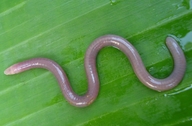|
Gegeneophis carnosus (Beddome, 1870)
| family: Grandisoniidae genus: Gegeneophis |
 © 2009 K.P. Dinesh (1 of 2) |
|
|
|
Description In life, the body coloration is pinkish-red, with the dorsum slightly darker than the ventrum. The head and collars are lighter, more yellowish-pink, and the snout and jaws are light yellow (Malathesh et al. 2002; Daniel 1963; Taylor 1968). Gegeneophis carnosus can be confused with G. ramaswamii, particularly small G. ramaswamii. The main difference is that G. carnosus has visible eyes, but it is difficult to determine the visibility of the eye in small specimens without a microscope and good lighting (Giri et al. 2003). These species overlap in the number of primary annuli (101-110 in G. carnosus, 98-104 in G. ramaswamii), though they differ in the number of secondary annuli (7 in G. carnosus, 8-14 in G. ramaswamii (Malathesh et al. 2002). G. carnosus has a more slender body that is nearly uniform in width, while G. ramaswamii has a thicker body that is widest at the terminus (Malathesh et al. 2002). Distribution and Habitat Country distribution from AmphibiaWeb's database: India
Life History, Abundance, Activity, and Special Behaviors Trends and Threats Comments
References
Beddome, R. H. (1870). ''Descriptions of new reptiles from the Madras Presidency.'' Madras Monthly Journal of Medical Science, 2, 169-176. Daniel, J.C (1963). ''Field guide to the amphibians of Western India, Part 1.'' Journal of the Bombay Natural History Society, 60(2), 415-438. Giri, V., Wilkinson, M., and Gower, D. J. (2003). ''A new species of Gegeneophis Peters (Amphibia: Gymnophiona: Caeciliidae) from southern Maharashtra, India, with a key to the species of the genus .'' Zootaxa, 351, 1-10. Gower, D. J., and Wilkinson, M. (2005). ''Conservation biology of caecilian amphibians.'' Conservation Biology, 19(1), 44-45. Gower, D., Wilkinson, M., Oommen, O. V., Measey, J., Dutta, S., Bhatta, G., and Ravichandran, M. S. (2004). Gegeneophis carnosus. In: IUCN 2008. 2008 IUCN Red List of Threatened Species. www.iucnredlist.org. Downloaded on 13 April 2009. Malathesh, G. M., Gundappa, K. R., Reddy, S. R., and Shakuntala, K. (2002). ''A redescription of Gegeneophis carnosus (Beddome, 1870) (Amphibia: Gymnophiona).'' Zoos' Print Journal, 17, 723-728. Taylor, E.H. (1968). The Caecilians of the World. A Taxonomic Review. University of Kansas Press, Lawrence, Kansas. Originally submitted by: Kellie Whittaker (first posted 2009-04-12) Edited by: Kellie Whittaker (2009-04-13) Species Account Citation: AmphibiaWeb 2009 Gegeneophis carnosus <https://amphibiaweb.org/species/1881> University of California, Berkeley, CA, USA. Accessed May 13, 2025.
Feedback or comments about this page.
Citation: AmphibiaWeb. 2025. <https://amphibiaweb.org> University of California, Berkeley, CA, USA. Accessed 13 May 2025. AmphibiaWeb's policy on data use. |



 Map of Life
Map of Life